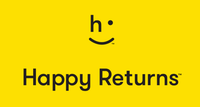Wednesday, September 5, 2018
Interview with David Sobie, Happy Returns

Why is it that consumers overwhelming prefer to return unwanted products in person, rather than by mail--and how do you make that complex and cumbersome process easier for both consumers and online retailers? Santa Monica-based Happy Returns (www.happyreturns.com) is solving that issue, with a network of "return bars" it has opened in partnership with physical retailers. We chatted with co-founder and CEo David Sobie about the company and the problem it's solving.
For those who have never used Happy Returns, tell us how the service works? David Sobie: We are tackling the very unhappy challenge of returning products purchased online. We do that,by enabling in-person returns for online shoppers. If you ever purchase something you'd like to return to an online store, we enable those online returns, even for retailers who don't have physical stores. We do that through a network of physical locations, which we call Return Bars, all around the country. You may have seen our announcement that we now have 200 of these in 40-some metro areas, where you can bring your items to our Return Bar, and return those in person. You don't need to print anything out, or put it in a box, or use packing tape. More importantly, you get your refund on the spot. That in-person return eliminates the hassle and wait for returns by mail, and is good for consumers, because it gives them what they really want, and they do not have to do any work to get their money back as soon as possible.
How did you start Happy Returns?

Davie Sobie: I worked together with my co-founder, Mark, at Hautelook. We ended up being acquired by Nordstrom. One of the programs we worked on was letting HauteLook shoppers who bought items online return them at Nordstrom Rack stores. The insights Mark and I gained on that program led to us founding Happy Returns. There were three key insights we found there. First, if you give online shoppers the choice of returning something by mail or by person, they will return in-person. HauteLook saw that very quickly. Customers heavily adopted in-person returns. Instead of mailing items back, they would take them to Nordstrom Rack stores. The second insight, was that food traffic from returns was really valuable. We saw the steady stream of customers Nordstrom Rack was getting from HauteLook shoppers, and we realized that we could do that same thing with any retailer. We could provide a steady stream of Internet shoppers at our Return Bar, and use that foot traffic to build out our network, and help anyone operating a typical retail store with providing foot traffic. The third insight, was seeing how challenging returns are, and how costly and expensive they are for online retailers. Customers expect the retailers to pay for those returns, they expect returns to be free, and they expect outbound shipping to be free. There really aren't any good ways for retailers to combat the rising cost of returns. Returns by mail are really inefficient. A third party network like what we have created to solve customer problems, also solves problems for retailers, because they can aggregate those returns before they are shipped back. Retailers provide a better customer experience, and they're also saving money. The simple math, is rather than an individual customer mailing lots of individual boxes, Happy Returns aggregates those items together in one box, with lots of things, rather than mailing lots of boxes. That really saves money on shipping costs for those retailers.
What have you learned so far from the experience of Happy Returns?
David Sobie: Next month, in September, it will be three years since we founded and incorporated the business. Some of the big milestones we did, include a seed round of financing in the fall of 2015, which was led by Upfront Ventures. That seed funding was really to let us prove the concept and build the technology to enable returns in person at retailers, and let us figure out whether or not customers wanted to return this way, and get an idea of how to scale. We checked all of those boxes, and then went back out to market in Spring of 2017, last year. We managed to raise our Series A, which was also led by Upfront Ventures. That was an insider round, where ssetnailly, Upfront led and angel Brian Spaly, the former co-founder of Bonobos and the CEO of Trunk Club ended up investing. He head been a small investor in our seed round, and became a much bigger investors in our Series A round. That money was meant for us to expand. We went from six locations when we closed our Series A, to fifty locations by the end of last year. I think what we realized along the way was one, we figured out how to scale. We figured out it mad the most sense to partner with retailers with existing locations, rather than to open and operate our own locations. The model of the Return Bar, and working with companies like Paper Source, made sense. They were interested in the foot traffic that represented, and we provided the technology and training. They provide the physical space and the staff. We trained their store associates, and provide them with equipment, including an iPad and a Happy Returns app, which allows them to accept and process returns. It's a good, symbiotic relationship. They have a branded, high quality retail environment we can send customers into, and what they get, is a customer walking in the door. That customer not only hears that their return can be processed, they hear then have $150 back on their American Express card. Now, they're already at Paper Source or in a shopping mall—we hae a lot of locations in shopping malls—and what they are likely to do is look around and check out what is there. We went from those six locations to fifty using that model of location partners after that Series A, but every location at that point was a one-off. After we closed our Series B last year from US Venture Partners, that was really about going from 50 locations to several hundred, getting us to scale, and expanding our partnerships with retailers. It's now not just about providing returns in person, but it's solving the entire problem of returns. Today, we help enable returns in-person, but we also provide software for retailers that want to outsource their return portal. An example is Outerknown, which is Kelly Slater's apparel brand. If you have to do a return with Outerknown, it's entirely hosted by Happy Returns. So we're getting more into the software side, and handling returns by mail, where customers mail returns to us where it goes to our warehouse to be processed and aggregated, and then sent back if those items can be resold. That's just a high level tour of the lat three years and our big milestones.
You were in a pilot with Paper Source before they agreed to take this across their entire network. What convinced them to expand what they were doing with you?
David Sobie: There were two things for them. We approached them, and said we could train their teams and make it very easy. We did a pilot in two cities, Los Angeles and Chicago. What they want to see, was one, is this going to be easy for our store associates to use. They wanted to validate that our technology worked, that the staff could handle it, and it wouldn't be a big imposition on their teams. The second thing, was could we drive a meaningful amount of traffic into their store. They wanted to see what kind of incremental traffic they would receive, and figure out how many customers are discovering Paper Source for the first time, and if those customers were going to buy something. The value to Paper Source from the partnership is about the awareness and foot traffic, and see if that foot traffic means they will buy something once they do a return. The test ran from mid-February, when we launched after valentine's day in LA, and in Chicago in March. In summer, we got together to review after 90 days, and they already were seeing traffic sale, seeing customers convert, and realized that it was relatively easy for their staff to do. That's when we started talking to them about the expansion. It was easier to roll out to all of their stores rather than just some. We ran out across all of them, and ran training programs across their network, not just some of the stores. Our plan had to to necessarily be in all the stores, as we have a methodical plan to get into the top metro areas. But, the opportunity to be in every Paper Source was too awesome to pass up.
That now takes us into metro areas we were not planning to be in right away, big metros like Nashville, Virginia Beach, Madison Wisconson, and other cities that weren't initially a part of our plan. That's because Paper Source is such a great partner, and provides such a high quality experience.
What's next for you now?
David Sobie: Right now, it's all about Paper Source and the other partnerships we have with locations. We now have close to 300 locations, which is super exciting. We feel pretty good on the growth of our locations, and we're now focused on getting all of our retailers live on the platform ahead of the busy holiday season. We've also signed a number of agreements with retailers, which we have not yet announced. We have some pretty big household brand names in our pipeline, too, which we are working feverishly to close. That's our focus now, really looking ahead about bringing the whole thing together, the software, logistics pieces, and really serving retailers across multiple parts of the return problem. By offering up the customer return portal we'll have a full solution for the market that no one else does. The logistics companies with return solutions are all based by mail, and we're the first company really to have both in-person returns for customers. The economics of this also get better the more scale we have. 2019 will be all about more and bigger, with a bigger retail presence and services we offer.
What's the biggest piece of advice you'd give to other entrepreneurs?
David Sobie: That's a great question. There are two things. One, is pick a great co-founder. Mark and I really work well together, and there's a level of trust in our relationship which lets us be brutally honest with each other, but also supportive. There's many great entrepreneurial stories out there, where the relationships or set of relationships with people behind a business are really important, and we're no exception to that. The other piece, is take whatever your plan is as an entrepreneur, and multiply that by 2X from a time perspective. It's important to take double the time and cost of what you are doing, and figure out, is this still a good idea? Everything takes longer and costs more money, and is hard to do that it is on paper. Even the plans we though we were being conservative ended up being harder to accomplish than we first thought.
Thanks, and good luck!